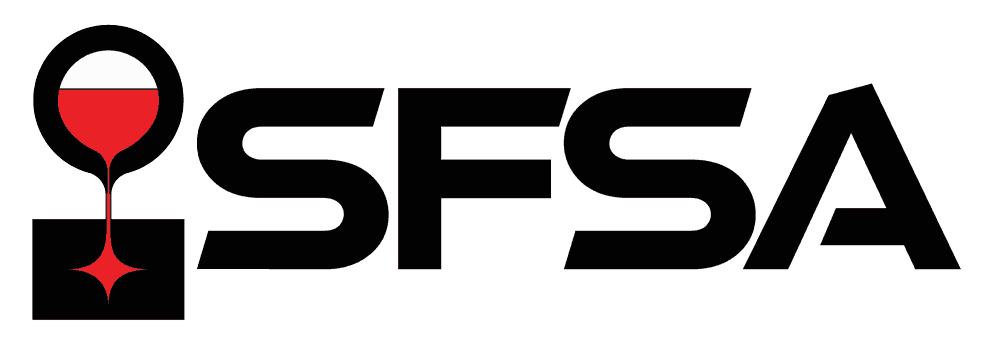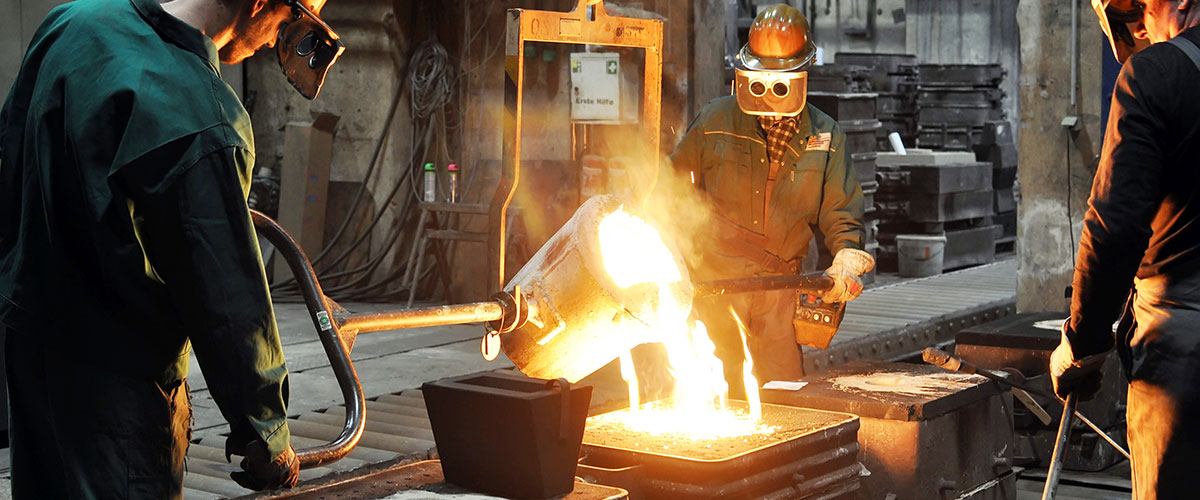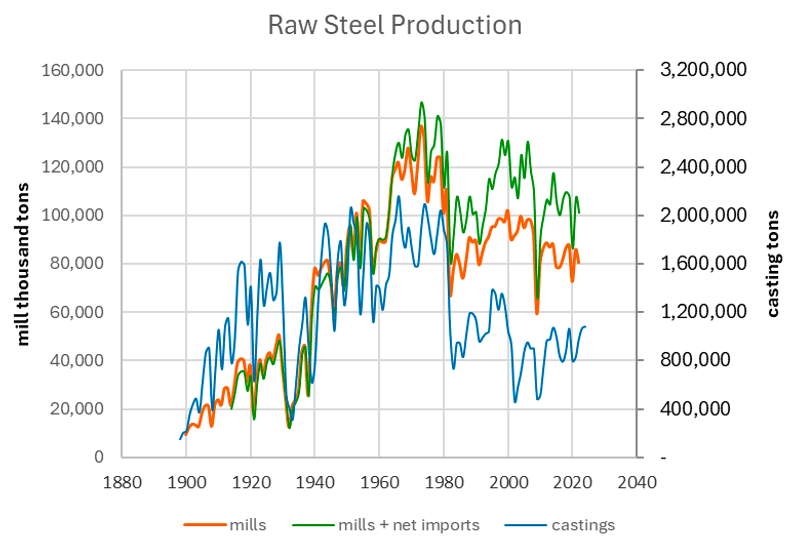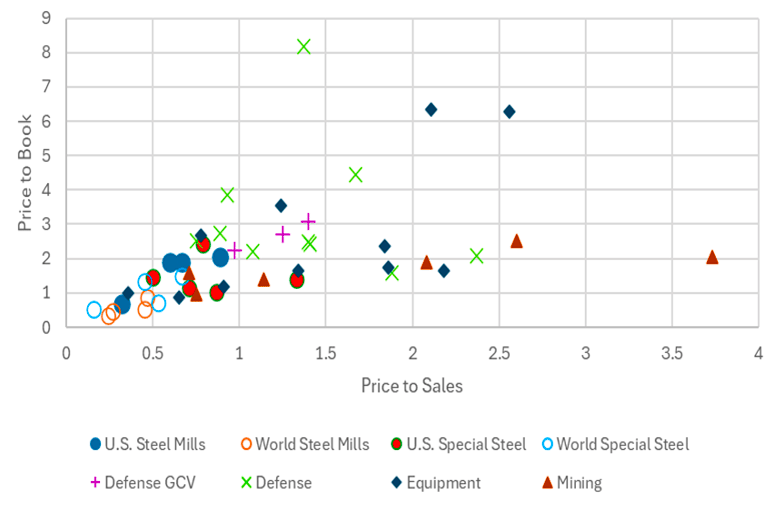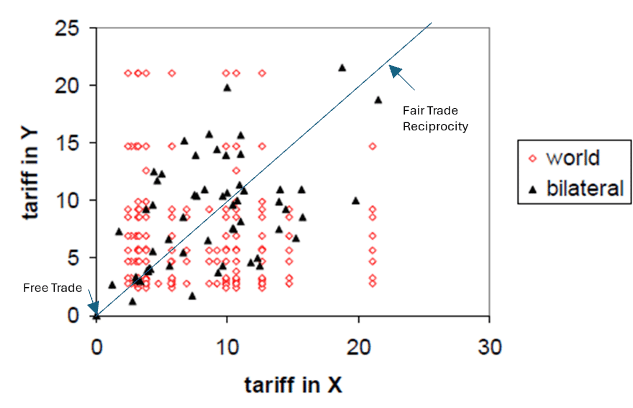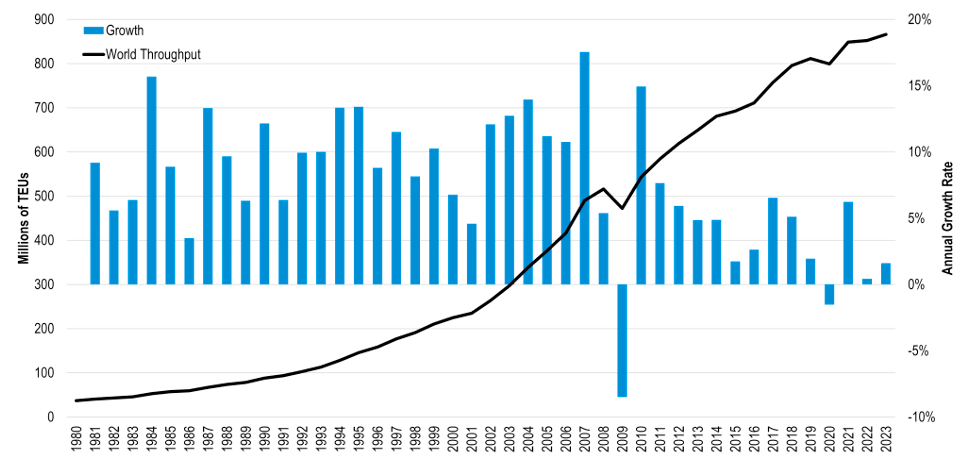Table of Contents
Cast in Steel 2025 Competition
You’re Invited to the 2025 Cast in Steel Competition!
We are thrilled to invite you to the 2025 Cast in Steel Competition, featuring George Washington’s Swords. This year’s event is going to be more exciting than ever, as we’re turning the entire competition into a TV series!
Join us as 49 teams from 34 universities battle it out for the title of Grand Prize winner. As always, it’s going to be an action-packed, edge-of-your-seat experience you won’t want to miss.
| UNIVERSITY NAME: | TEAM NAME |
|---|---|
| Arizona State University | George Slashington |
| Baylor University | George Washington Carvers |
| California Polytechnic State University, San Luis Obispo | SLO, Smooth, and Solid |
| California State Polytechnic University, Pomona | The Paul Reveres...The Broncos Are Coming |
| California State Polytechnic University, Pomona | Team Vernon Vanguard |
| California State Polytechnic University, Pomona | Crucible Crew |
| California State Polytechnic University, Pomona | Molten Metal Marauders |
| Central Michigan University | Fired Up Casting |
| Colorado School of Mines | George Washing-Ton of Steel |
| École nationale supérieure d'arts et métiers | Les moines Clunsois |
| Georgia Southern University | Southern Steel Company |
| Georgia Southern University | Partners in Crime |
| Georgia Southern University | The 4 Musketeers |
| Grand Valley State University | The Great Lake Tea Tossers |
| Instituto Tecnológico de Morelia | Alloys Avengers |
| Instituto Tecnológico de Saltillo | Liberty blade |
| Instituto Tecnológico de Saltillo | Blade forgers |
| Iowa State University | Cy-Cast |
| Michigan Technological University | Washington Wompers |
| Michigan Technological University | The Founding Founders |
| Michigan Technological University | The steel toed boots |
| Missouri University of Science and Technology | MSTeel |
| Pennsylvania State University - Erie, The Behrend College | Behrend Bladesmiths |
| Pittsburg State University | Silverback Swords |
| Purdue University- West Lafayette | Boiler Up |
| Purdue University- West Lafayette | Hammer Down |
| Saint Martin's University | Brotherhood of Steel |
| Tennessee Technological University | Foundry Fathers |
| Tennessee Technological University | FORGE OF FREEDOM |
| Trine University | Foundry of Freedom |
| University of Alabama | Steel Team 6 |
| University of Alabama | Swordge Washington |
| University of Alabama at Birmingham | UAB Blazers |
| University of Dayton | SWORD Team Six |
| University of Northern Iowa | UNI Metal Casters |
| University of Wisconsin-Madison | Blazing Badger Bladesmiths |
| Virginia Tech | Swordy McSword Face |
| Virginia Tech | Iron Maidens |
| Wentworth Institute of Technology | Stars and Steel |
| Wentworth Institute of Technology | Foundry Fathers |
| Youngstown State University | George Washinguin |
| University of Tennessee Knoxville | Sword Washington |
| University of Wisconsin - Platteville | Pour'n Pioneers |
| The Ohio State University | Brutus’ Brutality |
| University of California, Irvine | Zotsmithing |
| Western Michigan University | Blazin' Broncos |
| Arkansas State University | Red Wolf Steel |
Event Details:
Competition
Thursday, April 10th: 9:00 AM – 6:00 PM (end time may vary due to filming)
Friday, April 11th: 8:30 AM – 6:00 PM (end time may vary due to filming)
Location: Studio Space Atlanta, 3080 McCall Drive, Atlanta, GA
RSVP by April 1st to we’re sure to have enough seats and lunches.
Awards Ceremony
Saturday, April 12th, Time: 3:00 pm
Location: CastExpo, Georgia World Congress Center, Room A411
On Sunday, be sure to visit the FEF booth at CastExpo to see all of George Washington’s Swords on display.
Casting Dreams
The Casting Dreams National Competition will be held April 14
We’re wrapping up the final Regional Competitions and it’s been an incredible journey! With 31 organizations and schools and over 500 young people participating, Casting Dreams has truly inspired the next generation of casting talent.
Now, it’s time for the National Competition and we’d love for you to join us!
Event Details:
Date: Monday, April 14th
Time: 3:00 PM
Location: AFS HUB, CastExpo
Be sure to stop by the HUB early to see the incredible castings submitted by these talented students. You’ll be amazed by their creativity and skill.
Don’t miss this chance to see the bright future of the industry – you won’t believe the talent on display!
SFSA Members Lunch & Roundtable Discussion
Members are invited to join SFSA for a lunch for members Saturday, April 12th at 11:30 a.m. The event will take place at Max Lager’s Wood-Fired Grill & Brewery, located at 320 Peachtree Rd NE, Atlanta, GA.
This will be a great opportunity to network with fellow SFSA members and engage in a steel foundry roundtable discussion following lunch.
To secure your spot, please register and make payment by Monday, March 31st
Specification Committee Meeting
SFSA is actively involved in American Society for Testing and Materials (ASTM), International Organization for Standardization (ISO), Boiler and Pressure Vessel Code (BPVC), and American Welding Standard (AWS). The specification bodies foster collaborative development of commercial standards, which SFSA will work with to transition technologies into new or existing standards. These efforts are led by our Specification Committee, which will meet on May 6th in Toronto, Canada. For more information, please contact Dave.
79th Technical & Operating Conference
The T&O Committee is in the process of setting up this year’s conference. It will be December 10-13 at the Loews Hotel in Chicago. If you would like to recommend a topic and presenter, please contact Dave.
Research Review, July 8-10
Please make your plans to participate in the annual SFSA Research Review on July 8-10. This year’s meeting will be held in-person in Rosemont, IL. The Review covers the latest in both Carbon & Low Alloy and High Alloy steel casting research under the AMC and STAR programs. The meeting is also your opportunity to interact with the researchers and provide industry steering. The event vets our research portfolio to select the R&D projects to be featured at the National T&O. More details regarding registration and the Design Day are to come. For any questions, contact Caelan Kennedy (ckennedy@sfsa.org).
Research Committees
SFSA is working with the Carbon & Low Alloy and High Alloy research committees to publish final reports from research projects. If you would like to be involved in the review and approval of research reports, contact Caelan Kennedy (ckennedy@sfsa.org).
Making Steel Castings Webinar Series
The complete member Making Steel Castings webinar series now includes feeding & risering guidelines, a thorough discussion on the trade-offs in how to make steel castings, a case study and discussion of gating, chills and filters. The webinars were framed around Wlodawer’s book, “Directional Solidification of Steel Castings” but tie in today’s simulation technology. This series was made possible with the support of SFSA alumni George Hartay, Steve Gear and Tim Hays. Plans are currently underway for a public webinar on Making Steel Castings to promote collaboration with customers.
Foundry Property Insurance Program
Diebold Insurance Agency recently announced a property insurance lineslip with Amwins Global Risk created specifically for foundries and other metal manufacturers. This program aim is to give solutions to insureds who have seen the effects of aggregates or cover being restricted due to various domestic markets pulling out of the heavy industry sector. Please click here for a one-page overview. Please note that Diebold has been successful in placing insurance for foundries under the minimum premium noted on the flyer. For additional information, contact Jeff Musselman of Diebold Insurance Agency – jeffrey@dieboldinsurance.com.
Market News
Beginning this month, the SFSA business trends data will no longer be included in the Casteel Reporter. Data will only be made available to survey participants. The link to the monthly survey will be provided in the Market News. Please complete the business trends survey for February 2025 to receive the survey results. https://www.surveymonkey.com/r/SFSA_BTB_Feb25 Survey results are provided early the following month.
Casteel Commentary – Steel: Trade and Tariffs
Steel is fundamental to economic development and production grows with increasing demand for building infrastructure and population growth. This growth in steel requirements can be easily seen in Figure 1. While the total steel required from mills including imports has continued to grow, steel castings have declined sharply, and mill products stagnated. But domestic production was supplemented by imports to continue to meet the needed supply. Why did steel production in the US stagnate after 1980 and the need for castings decline? Why are imports used to supplement domestic production? Why is the production of steel castings historically low? How has trade impacted our industry in North America?
The relative value of steel in the U.S. is shown in Figure 2. This is estimated by dividing the change in price by the value of money. It shows that steel as an essential component for capital goods has a roughly 30-year business cycle.
This can be seen in Figure 1. In the beginning of the modern industrial economy, production grew rapidly until 1929 and the depression hit until recovery was stimulated by WWII production. This recovery and investment to transition to a post war economy peaked in the late 1950s. This peak can be seen in Figure 2 in the peak value. The decline in value after the peak was the slow absorption of the excess capacity installed. This capacity was inadequate in the oil crisis, the abandonment of the gold standard and the rising inflation and interest rate. The value of materials, especially steel, is seen in the sharp rise in value in the early 1970s. The question of why there was the rapid decline after 1980 is due in part to the excess investment during the boom. Surprisingly though, why did we not see significant investment in steel foundries and mills in the rapid increase in value from 2004 to 2014?
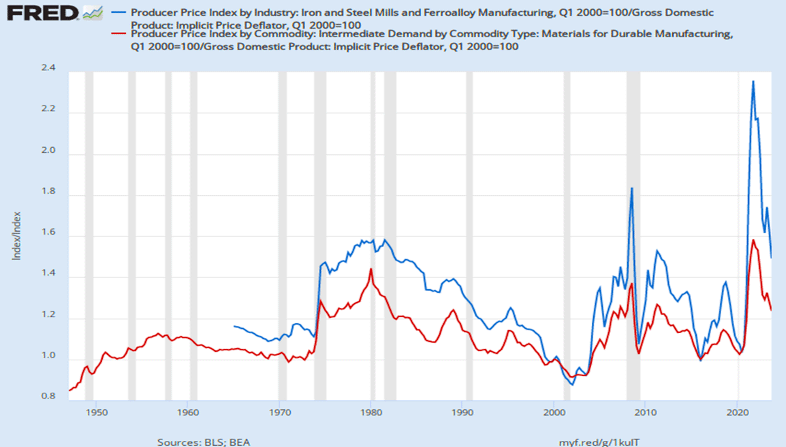
This investment cycle is shown in Figure 3. The peak value of private capital equipment occurs at value peaks in Figure 2 in the late 1950s and late 1970s but not in the early 2000s. One explanation that has merit is shown in Figure 1. Imports of not only steel limit the demand for steel products but imports of competitors of our customers limit our domestic production. One fundamental policy issue is the framework for trade agreements. Trade agreements are mercantilist even by North America. For the U.S, trade negotiation must prioritize services and their treatment as being more important part of the economy and a net exporter. This can be seen in the trade balances in Figure 4.
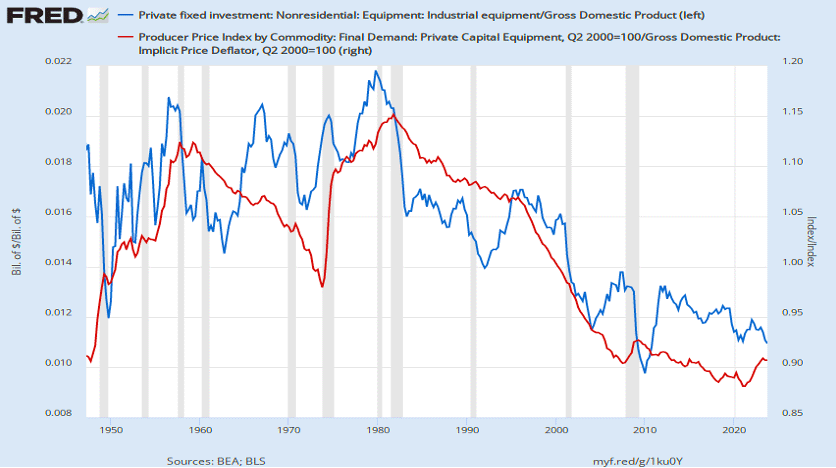
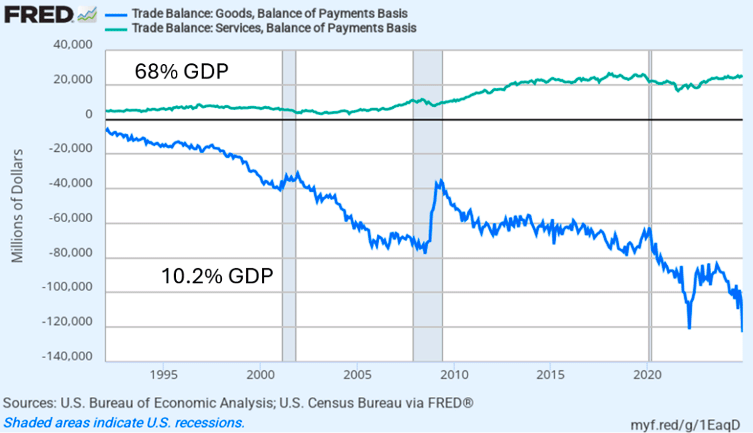
Steel producers outside of North America sell standard steel products well below the price charged by our domestic producers. Economists routinely attribute the challenges of the steel industry to inefficiencies and lack of competitive investments in North America compared to their global competitors. The core idea is that global suppliers are capable to producing steel at lower costs due to their competitive advantages. Are North American steel producers less capable?
As can be seen in Figure 5, the U.S. is competitive in the cost of manufacturing but is expensive in the market price. Is this the result of protectionism allowing them to be more profitable than other competitive firms? Or is this the result of predatory geopolitical policies that allow other regions to sell their products at reduced cost with the deliberate strategy of domination and enhanced capability in economic and national security? How does China, the EU and the rest of the world sell steel at or below the cost of production as seen in Figure 5?
One way to look at the competitive environment of steel production is to look at the financial condition of the major publicly traded steel mill producers. The plot of the major global steel mills value by comparing the Market Capitalization (Price) with their accounting value (Book) and their annual revenues (Sales). The poor position of the steel production industry is clearly seen.
A typical goal for capital intensive industries is for their business value to be well above their book value, over 1, and above their annual sales level. To get a higher return on their investment than on the sales, the sales to book value is targeted at 2. Given the aggressive subsidies and predatory trading policies, the excess capacity for steel production has many of the global steel suppliers with values at or below their book value. U.S. mills are more profitable are still low in value. This shows that steel producers are operating like sunk investments without the profitability or capital needed to modernize or innovate.
Trade policy is a significant challenge for North American producers. Most people would consider reciprocity the idea behind fair trade but trade policy asserts that it is evenhandedness. So we treat China not like China treats us but the way we treat Canada. Free trade would be no taxes at the border. Typical trade agreements are shown in Figure 7.
One fundamental trade challenge is the almost universal use of Value Added Taxes (VAT) for most of our global competitors. VAT is allowed to be border adjustable. Many regions charge domestic suppliers at each step the incremental VAT for their operation. This is a primary source of tax revenues. Since these taxes are used domestically and the consumer pays the total at the end, the VAT is rebated for exports and charged on imports. This means in reality that VAT on exports is rebated and VAT is charged on imports. The VAT is a type of sales tax so Figure 8 shows the U.S. with a sales tax regime. Macro-economists argue that the tax is trade neutral since the countries’ currency value will adjust to overcome this border adjustability. U.S. producers suffer both from the VAT and from currency exchange rates. Economists claim these monetary and tax policies are not factors in trade competitiveness, the reality in multi-national organizations is that both are factors on regional competitiveness. The use of the VAT with border adjustability and the U.S. dollar as the reserve currency of the world are both factors in the global competitiveness of U.S. producers.
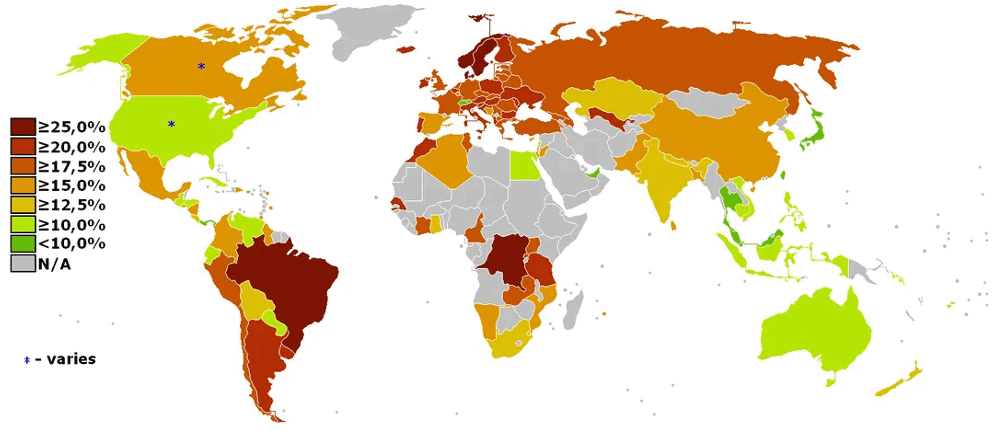
In addition to predatory competitors with excess capacity depressing pricing, trade agreements that are allowing these abuses, tax and currency policies burdening producers, containerization altered the global trade economy. Trade laws and limits of predatory or market distorting trade practices are subject national to laws that were formulated pre-containerization. Shipping high value commodity custom products was expensive and risky. Trade laws were directed at bulk commodities like agriculture steel, oil, and other bulk products. These products are commodities with clear identities and can be monitored.
Containerization reduced the cost of cargo shipping by 90%. In 1956 cargo cost $5.86/tn but dropped to $0.16 after containerization. Pre-containers, cargo was loaded at 1.3 tons an hour. You loaded a boat like you loaded a moving van. With containers that can weigh 25 tons and be loaded 40 per hour per crane with multiple cranes working, containerization made global supply chains possible. Shipping became almost as easy and inexpensive as trucking or rail.
This move to containers allowed global suppliers to prey on small markets with high value and limited suppliers. It allowed global participants to make simpler low cost items. It allowed less sophisticated suppliers to supply lower cost and less critical items. It allowed regions that entered to market for parts to move up the value chain and not only replace our castings but also our customers.
The loss of volume reduces the demand and size of the industry. It also makes it financially difficult to have the business volume to maintain the facility and the staffing. The idea that we as U.S. suppliers can exist on the high value-added production without the traditional volume we produce was short sighted. In fact of course the idea was in global peaceful world, global suppliers could provide these products without the need for domestic sources.
Trade is a market function with the lowest cost suppliers with the best value in the market winning. Our competitors do have a compelling market case with lower prices based on lower costs. The challenge is that their competitive advantage is not better productivity or higher value but regional commercial practices and public policy. U.S. suppliers were regional prior to 1980.
Our biggest challenge is the lack of profitability to modernize, automate and innovate. Global trade and overcapacity have limited us by reducing demand and depressing pricing. It also made our domestic market smaller by displacing our customers as well. We also suffer from the economic externalities imposed on manufacturing when we were a regional economy. Our corporate tax system is an artifact of our domination in the world economy. We were capable of imposing costs for health care, retirement, environment, training, regulatory compliance, social justice preferences, etc. that added cost. When the global economy become a larger factor, the U.S. producers were found to be at a 40% cost disadvantage to the developing economies and a 20% disadvantage to the developed world. Figure 4 shows these costs embedded into the U.S. price for steel that has the same production costs as the rest of the world. The low market value of steel producers in Figure 6 shows that the North American producers are in the same challenged rut as the rest of the world financially but are in worst shape due to an eroded market and imposed high costs.
One final challenge is the shift that occurred after the excess capacity of the 1980s and then the rapid industrialization after 1990 in the developing world. For most of the industrial age, large equipment suppliers and our other customers depended on our production. Purchasing’s main task was to develop capable and stable suppliers, not to find the lowest possible cost products. With business cycles and continuing moving technology, it was necessary to collaborate with the supply chain to ensure that they remained up to date and capable of supply requirements. With the excess capacity globally, purchasing chased the lowest cost and drove ordinary pricing to be tied to the cost of production. Earlier, the purchaser was concerned that the supply chain remained profitable enough beyond pure cost recovery to invest and innovate.
Steel producers do get more of the product value when the industry capacity limited in supplying demand during sharp market upturns like after COVID. In 2021, the cost of HRC $/tn in the U.S. rose to $707 and the selling price rose to $1763. This steep rise shows the market price when set by the product value that is well beyond the cost of production. Being able for steel foundries to capture not only the cost of production but also some of the market value will be critical to profitability and reinvestment.
Tariffs have not covered steel castings in most instances. Steel castings defy categorization and are normally not subject to tariffs unless blanket reciprocal tariffs were instituted. The steel casting industry in Mexico and Canada is small and necessary for our regional economy and will be critical to provide the castings needed for re-regionalization. Our regional challenge is to reconstitute the steel casting industry so that we are profitable enough to invest, modernize, automate and innovate..
Trade policy has limited steel makers and especially casting producers from the profitability we need to invest, innovate and grow. The current recognition that domestic producers are essential to national and economic security is heartening but not clearly focused or directed at the core issues. Trade policy had long been understood in the steel mill industry as a fundamental requirement for the ability to be a reliable and capable supply chain. We also realize that tariffs do not address the underlying geopolitical trade issues, the predatory practices, the public policy cost burdens that limit domestic supplier competitiveness or underlying workforce and regulatory limits. But tariffs may be a necessary tool to allow North American suppliers to profit by reducing or eliminating to cost disadvantage of predatory global competitors.
Raymond
| STEEL FOUNDERS' SOCIETY OF AMERICA BUSINESS REPORT | ||||||||||
|---|---|---|---|---|---|---|---|---|---|---|
| SFSA Trend Cards (%-12 mos. Ago) | 12 Mo Avg | 3 Mo Avg | January | December | November | |||||
| Carbon & Low Alloy | ||||||||||
| Shipments | -6 | -10.4 | ||||||||
| Bookings | -7.2 | -1.7 | ||||||||
| Backlog (wks) | 9.3 | 8.8 | ||||||||
| High Alloy | ||||||||||
| Shipments | -1.5 | -4.5 | -8.5 | -10 | 5 | |||||
| Bookings | 0.6 | -4.2 | 0 | 3.3 | -16 | |||||
| Backlog (wks) | 9.2 | 8.6 | 9.5 | 8.8 | 7.5 | |||||
| Department of Commerce Census Data | ||||||||||
| Iron & Steel Foundries (million $) | ||||||||||
| Shipments | 1,652.40 | 1,656.00 | 1,624 | 1,646 | 1,698 | |||||
| New Orders | 1,685.20 | 1,750.30 | 1,662 | 1,743 | 1,846 | |||||
| Inventories | 3,283.50 | 3,380.30 | 3,380 | 3,386 | 3,375 | |||||
| Nondefense Capital Goods (billion $) | ||||||||||
| Shipments | 84.1 | 85 | 87.8 | 85.1 | 82 | |||||
| New Orders | 84.5 | 85.2 | 90.6 | 80.3 | 84.8 | |||||
| Inventories | 232 | 233.2 | 233.3 | 233.8 | 232.5 | |||||
| Nondefense Capital Goods less Aircraft (billion $) | ||||||||||
| Shipments | 73.9 | 74 | 74 | 74.2 | 74 | |||||
| New Orders | 73.9 | 74.7 | 75.1 | 74.5 | 74.4 | |||||
| Inventories | 163.1 | 163.4 | 163.3 | 163.4 | 163.6 | |||||
| Inventory/Orders | 2.2 | 2.2 | 2.17 | 2.19 | 2.2 | |||||
| Inventory/Shipments | 0 | 2.2 | 2.21 | 2.2 | 2.21 | |||||
| Orders/Shipments | 0 | 1 | 1.02 | 1 | 1.01 | |||||
| American Iron and Steel Institute | ||||||||||
| Raw Steel Shipments (million net tons) | 7.2 | 7.1 | 7.4 | 7.1 | 6.7 | |||||
